Honey bee farming has become a thriving industry in the United Arab Emirates, attracting both seasoned enthusiasts and curious newcomers. More UAE citizens are taking up beekeeping to improve honey production in the country and earn some extra income. Honey bee farming, also known as apiculture, is the art of raising honey bees for their valuable products. It involves creating an environment conducive to the growth and well-being of these remarkable creatures.
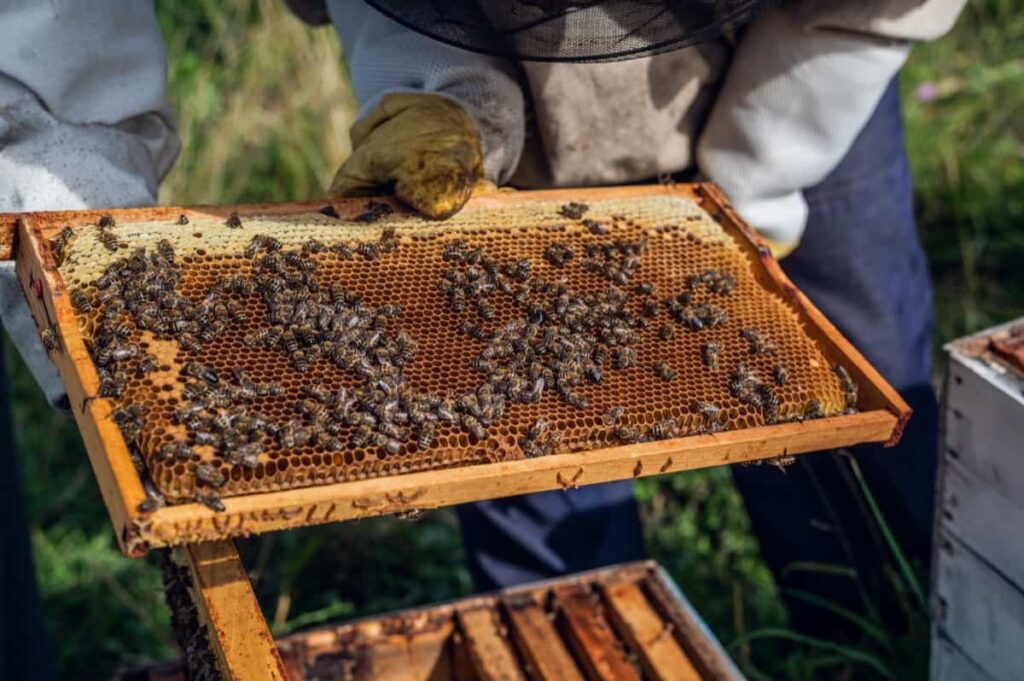
15 Steps to Start Honey Bee Farming in UAE
Different Types of Bees for Honey Bee Farming in UAE
Regarding honey bee farming in the UAE, farmers can choose from two main types of bees: Native wild honeybees (Apis Florea) and imported honeybees (Apis Mallifera). Firstly, we have the native wild honeybees, scientifically known as Apis florea. These tiny red-brown bees are also called Arabian or Asian dwarf honeybees. They measure between 7 and 10 mm, making them smaller than other honeybee species. Despite their small stature, these bees are crucial in pollination and contribute to the local ecosystem.
On the other hand, imported honeybees (Apis mellifera) are brought into the UAE from other countries for beekeeping purposes. Commercial beekeepers commonly use these bees due to their high productivity and ability to produce high-quality honey. Both types of bees offer unique advantages for beekeepers in the UAE. Native wild honeybees thrive in desert environments and have adapted well to local conditions. Imported honeybees, on the other hand, bring diversity and higher yields but require careful management and monitoring.
Beekeeping Business Plan in UAE
- Research and Education: Begin by educating yourself about beekeeping practices, local regulations, and market trends in the UAE.
- Set Clear Goals: Define your objectives for starting a honey bee farm, whether for personal consumption, selling honey locally, or expanding into other bee products.
- Location Selection: Choose a suitable location for your apiary that provides ample food sources (flowers) for bees and is easily accessible for maintenance.
- Equipment and Supplies: Invest in quality equipment such as beehives, frames, protective clothing, smokers, hive tools, feeders, and extractors to ensure smooth operations.
- Hive Setup: Properly assemble the hives according to manufacturer instructions and place them securely on stands or pallets to protect them from pests or flooding.
- Acquiring Honey Bee Colonies: Source healthy colonies from reputable suppliers in the UAE who offer queen and worker bees to establish strong colonies.
- Health Management: Regularly inspect hives for signs of disease or pest infestation; consult with local experts on preventive measures like organic treatments if necessary.
- Harvesting Techniques: Learn proper techniques for harvesting honey without harming bees; use appropriate tools like uncapping knives and extraction equipment.
In case you missed it: Natural Beehive Pest Management: Effective and Eco-Friendly Solutions
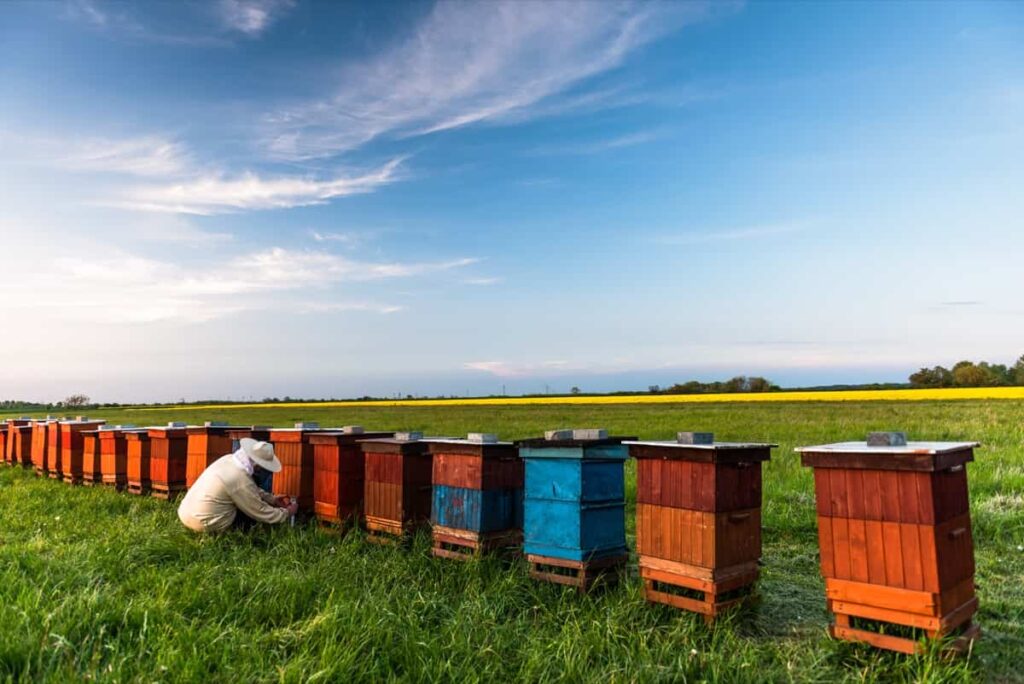
Choosing the Right Location for Your Honey Bee Farm in UAE
Choosing an area with abundant sources of nectar and pollen is important. This includes areas with diverse vegetation, such as gardens, fields, or even near farms that grow flowering crops. Honeybees thrive in warm weather, with temperatures between 15°C – 40°C. The UAE has a hot desert climate, so providing shade and water sources for your bees during the scorching summer months is essential.
Essential Equipment and Supplies for Beekeeping in UAE
- Beehive: Invest in high-quality beehives that provide a suitable environment for your bees to thrive. Choose hives made of durable materials like wood or polystyrene, which can withstand the harsh climate conditions in the UAE.
- Protective Gear: Beekeeping involves working closely with bees, so it’s crucial to have protective gear such as bee suits, gloves, veils, and sturdy boots. This ensures your safety while inspecting hives or harvesting honey.
- Hive Tool: This handy tool helps you separate frames from each other and pry open beehive components without damaging them.
- Honey Extractor: To harvest honey efficiently, invest in a good quality extractor that spins frames rapidly to remove honey without destroying the comb structure.
- Feeder: Bees need a constant supply of food, especially during times when nectar flow is low. Feeders help provide supplementary nourishment.
Setting Up the Hive: Step-by-Step Guide for Beginners
Firstly, choose a suitable location for your hive. It should be away from high-traffic areas and protected from strong winds. Ensure there is ample sunlight and a nearby water source for the bees. Next, assemble all the necessary equipment and supplies. This includes the hive bodies, frames, foundation sheets, smoker, protective gear (such as gloves and veil), and tools like a hive tool and bee brush.
Once you have everything ready, it’s time to set up the actual hive. Begin by placing the bottom board on a flat surface. Carefully insert frames with foundation sheets into each hive body. Make sure they are evenly spaced apart to allow for proper movement of bees within the hive.
Install an inner cover over the topmost box and an outer cover to protect against weather elements. Don’t forget to provide ventilation holes in both covers for airflow. Now that your hive is set up introduce honey bee colonies. You can purchase packaged bees or nucleus colonies from local suppliers in the UAE. Regularly inspect your hives to ensure their health and prevent any diseases or pests from spreading among them.
Obtaining Honey Bee Colonies: Where to Source Them in UAE
One option is to purchase honey bee colonies from local suppliers or fellow beekeepers. You can find reputable suppliers offering healthy and robust colonies suitable for your needs. It’s important to ensure that the bees come from reliable sources and have undergone proper health checks. Additionally, you may consider importing honey bee colonies from other countries. This option allows you to access different breeds of bees that may not be readily available locally.
In case you missed it: Beekeeping Management Practices: Season-wise Management of Honey Bee
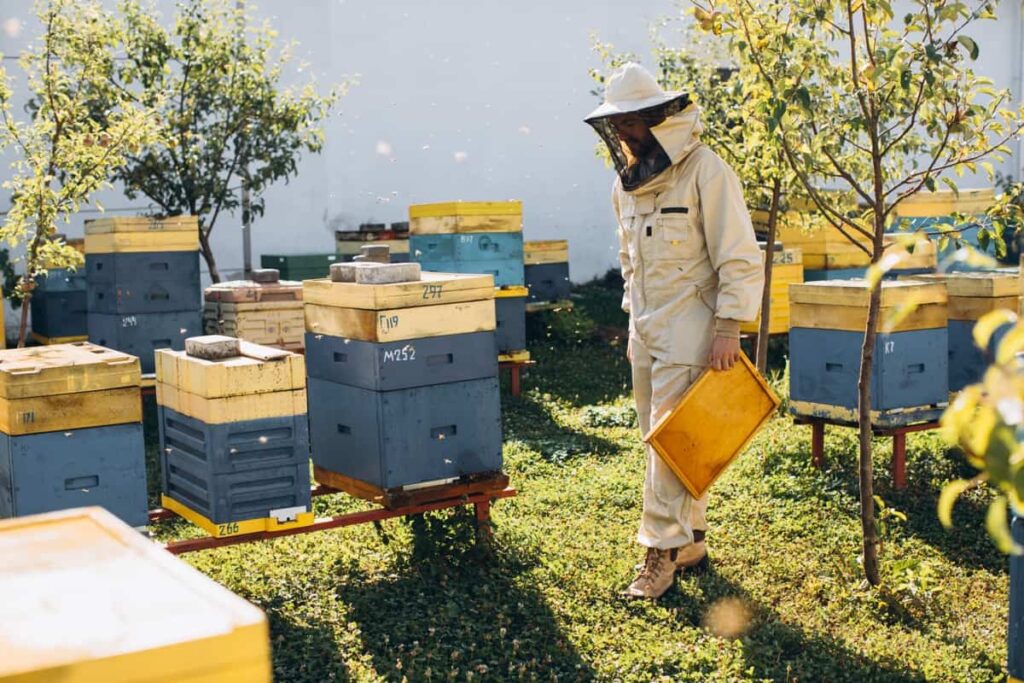
Managing Honey Bee Health and Disease Prevention in UAE
- Regular Hive Inspections: Conduct routine inspections to check for signs of disease or pests. Look out for abnormal behavior, such as aggressive bees or an unusually high number of dead bees.
- Hygiene Practices: Maintain clean hives by regularly cleaning equipment, removing debris, and replacing old combs when necessary. This helps reduce the diseases within the colony.
- Disease Monitoring: Stay vigilant by monitoring for common honey bee diseases. If any signs are detected, take immediate action according to recommended protocols.
- Beekeeper Education: Continuously educate yourself about best practices in beekeeping hygiene and disease management through workshops, training sessions, or online resources provided by local authorities or experienced beekeepers.
Harvesting Honey: Techniques and Best Practices for UAE Beekeepers
One key technique for harvesting honey is using a bee escape board. This device allows bees to leave the supers (the boxes where honey is stored) but prevents them from re-entering. By placing the escape board between the brood chamber and the supers, you can encourage the bees to move out of the supers before harvesting. Once you’ve cleared out most of the bees, it’s time to remove the frames containing capped honey.
Use a sharp knife or uncapping fork to remove the wax cappings from each frame carefully. Be gentle during this process to avoid damaging cells or harming bees. After uncapping, you have several options for extracting honey from the frames. One common method uses a centrifugal extractor that spins the frames rapidly, causing honey to fly out by centrifugal force. Another option is crush-and-strain extraction, where you crush comb cells with a fork or press and strain out liquid honey.
Once your honey has been extracted, it needs proper filtering before bottling. Filtering helps remove impurities like wax particles or bee parts that may have entered during extraction. You can use cheesecloth or fine mesh filters for this purpose. Store your harvested honey in clean jars or containers away from direct sunlight. Proper storage ensures that your delicious golden nectar stays fresh its flavor for longer.
Processing and Packaging Honey for Sale in the UAE
Once the honey has been harvested from the hives, it must be extracted from the comb. This can be done using various methods, such as centrifugal extraction or crush and strain. It is important to use clean and sterile containers to maintain the purity of the honey. Glass jars are often preferred for packaging as they showcase the natural color and texture of the honey. Labeling plays an important role in marketing your honey products.
Include essential information on your labels, such as the type of honey, origin, date of harvest, nutritional facts, and any certifications obtained. Sealing options like tamper-proof caps or shrink-wrapping can help maintain freshness. Remember that each bottle represents your brand identity, so pay attention to detail when designing your labels and selecting packaging materials.
In case you missed it: Beekeeping in South Africa: Requirements, License, Cost, and Training to Start
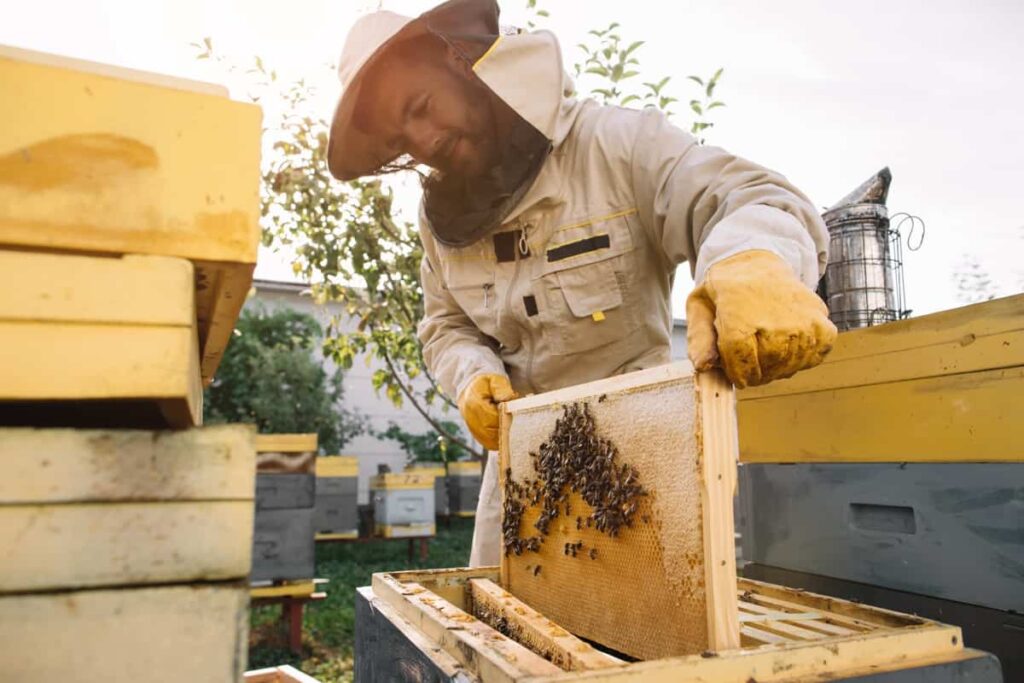
Diversifying Your Beekeeping Business: Other Products and Services to Offer
- Beeswax Products: Besides honey, beeswax is another valuable product that can be harvested from your hives. By offering these beeswax products, you can increase your revenue streams.
- Pollination Services: Many farmers rely on honeybees for pollination of their crops. You can provide pollination services by renting your colonies to local farmers during flowering.
- Educational Workshops: Share your knowledge and passion for beekeeping by conducting workshops or classes for aspiring beekeepers or schools interested in teaching students about the importance of honeybees in our ecosystem.
- Beehive Rentals: Some individuals may want to experience the joys of backyard beekeeping without committing fully. Renting out complete beehive setups and ongoing support could attract hobbyists eager to learn but not ready for full-scale apiary management.
Marketing and Selling Your Honey Bee Products in UAE
It’s important to establish a strong brand identity for your products. This includes creating an attractive logo and packaging design that reflects the high quality of your honey. Next, consider participating in local farmers’ markets or craft fairs to showcase and sell your honey bee products directly to consumers. In addition, don’t underestimate the power of social media in promoting your honey bee products.
Utilize online platforms like Instagram and Facebook to reach a wider audience. Collaborating with local restaurants or health food stores can also help increase awareness about your brand. Consider partnering with other local businesses that align with the values of sustainability and wellness. This could include spas, yoga studios, or eco-conscious retailers who may be interested in stocking your honey bee products.
Financial Planning and Budgeting for a Successful Honey Bee Farming Venture in UAE
Determine the initial startup costs, such as purchasing beehives, protective gear, and necessary equipment. Additionally, consider ongoing expenses like feeding bees, maintaining hives, and acquiring medication for their health. Creating a detailed budget will help you allocate funds effectively and keep track of your expenditures. Research local suppliers to find the best deals on equipment and supplies without compromising quality.
Establishing partnerships with local markets or participating in farmers’ markets can contribute significantly to your profits. Consider seeking financial advice from experts who specialize in agriculture or small businesses. They can assist you in making a realistic financial plan based on market trends and projected sales.
Legal Considerations and Regulations for Beekeeping in UAE
A permit or license from the relevant authorities is necessary before setting up your honey bee farm. This ensures that you meet all the required standards and protocols set by local authorities. It’s important to familiarize yourself with specific rules regarding hive placement, distance from residential areas, and colony management practices. Additionally, adhering to health regulations to prevent diseases among your honey bee colonies is essential.
Government officials or agricultural agencies may require regular inspections to monitor hive conditions and maintain hygiene. Moreover, awareness of pesticide usage restrictions is vital for responsible beekeeping in the UAE. Certain pesticides can have detrimental effects on bees’ health and can contaminate their honey production. Furthermore, keeping accurate records of your activities, such as hive maintenance, medication use (if any), and pest control methods, will help demonstrate compliance with regulations when needed.
In case you missed it: Backyard Beekeeping Cost and Tips for Reducing Backyard Beekeeping Costs
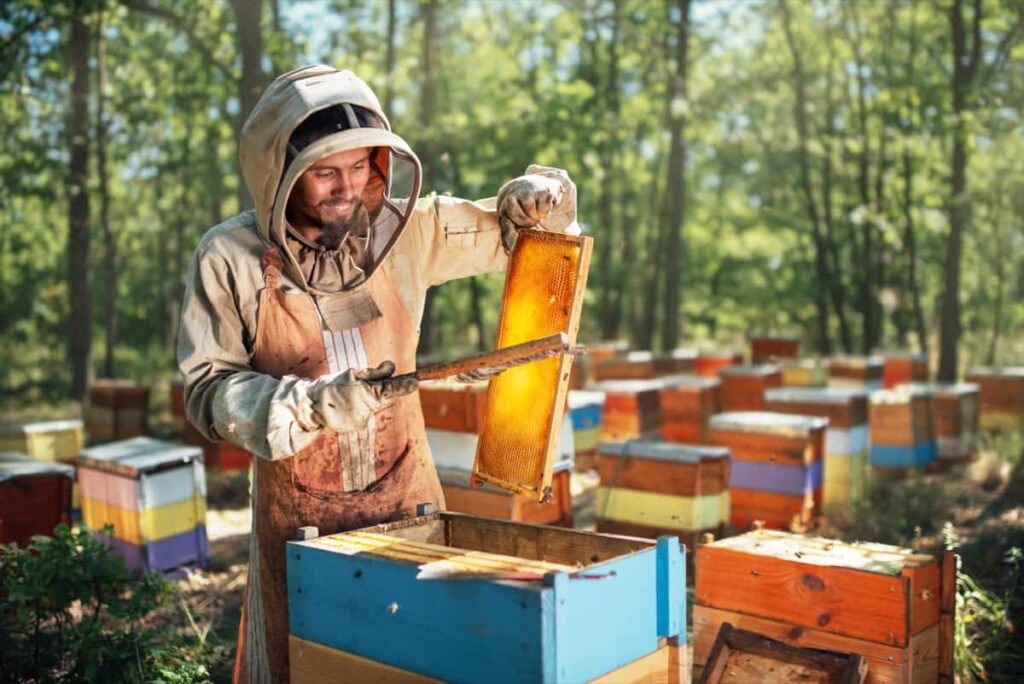
Environmental Impact and Sustainability Practices in Honey Bee Farming
One of the key environmental benefits of honey bee farming is pollination. Bees are excellent pollinators, and their activities help fertilize plants and ensure abundant fruit and vegetable yields. Farmers indirectly support local agriculture and boost food production by keeping bees. Moreover, honey bee farming promotes sustainability by preserving natural habitats. Beekeepers also play a crucial role in conserving native bee species in the UAE.
In terms of sustainable practices, many beekeepers prioritize organic methods by avoiding chemical treatments or pesticides that could harm both bees and the environment. Instead, they opt for natural hive techniques like IPM approaches. Additionally, some innovative beekeepers implement water conservation measures by providing efficient watering solutions for their bees while minimizing wastage. This supports responsible resource management within their operations.
Top 10 Honey Bee Farms in UAE
- Mukalla Hadhrami Honey Trading: Known for its pure Yemeni Sidr honey, this farm offers a range of natural and organic honey products.
- Al Sidr Natural Honey: Specializing in Sidr honey, this farm ensures their bees are kept in pristine environments to produce the finest honey.
- Hatta Honey Bee Discovery Centre: Located amidst stunning landscapes, this center allows visitors to explore the world of bees through interactive exhibits and educational programs.
- Royal Organic Honey: Committed to organic practices, this farm produces premium quality raw honey free from pesticides and additives.
- Atyab Asal: This farm takes pride in its locally sourced Emirati honey produced by native Arabian bees, offering unique flavors and health benefits.
- Atlas Honey: Dedicated to sustainable beekeeping methods, Atlas Honey produces artisanal varieties such as Acacia, Wildflower, and Mountain Sidr.
- Al Masar Honey: Focusing on traditional techniques passed down through generations, this farm produces rich and flavorful monofloral honey like Ghaf and Sumar.
- Alghizza Almalaky Honey & Herbs: Combining herbs with their raw wildflower honey creates unique blends with taste and wellness properties.
- Bees Hive Company: This family-owned business emphasizes natural hive management techniques, producing high-quality local honey infused with regional flavors.
- Saba Crown Foodstuff & Herbs: Offering an array of herbal-infused honey alongside their pure variants, Saba Crown provides customers with diverse options for different tastes.
Honey Bee Farming in UAE and Management Practices
| Important Aspects of Bee Farming in Uae | Proper Management Practices |
| Different types of bees in UAE | Native wild honeybees (Apis Florea) and imported honeybees (Apis Mallifera) |
| Well-structured business plan | This will help you outline your objectives, financial projections, and marketing strategies |
| The right location for a honey bee farm | Look for areas with abundant floral resources and minimal exposure to pesticides or pollutants |
| Essential equipment | Beehives, frames, protective gear (such as veils and gloves), smokers, hive tools, feeders, etc |
| Maintaining good health practices | Regular inspection of hives helps identify potential issues early on, providing a clean environment and managing pests effectively |
In case you missed it: Honeybee Farming Operations Management: Month-Wise Beekeeping Maintenance for Better Profits
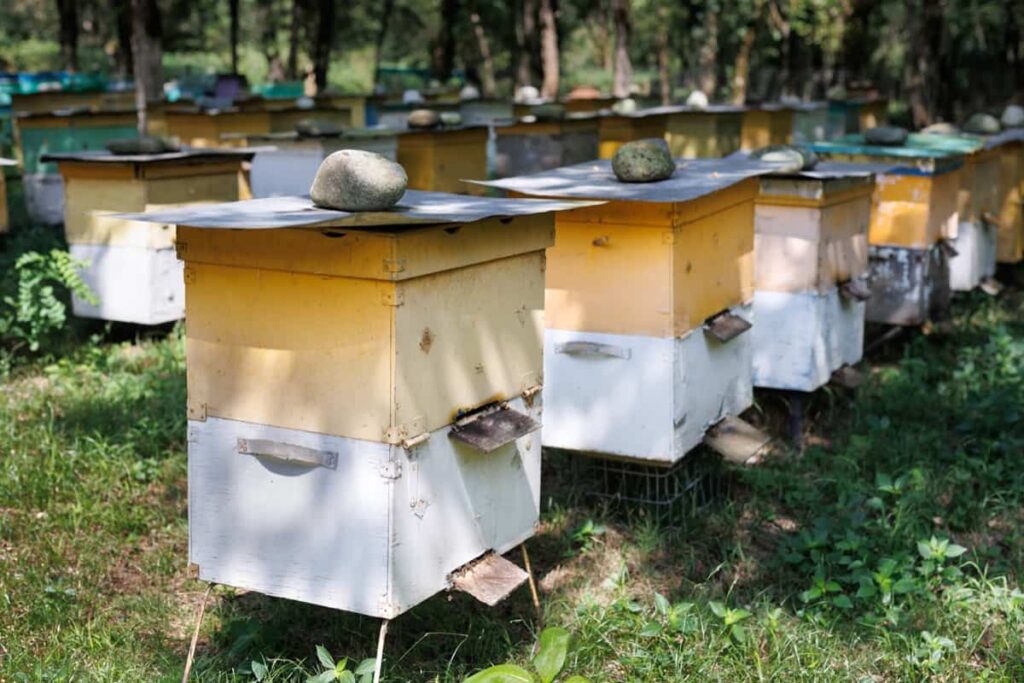
Conclusion
Honey bee farming plays a crucial role in the UAE, not only for its economic significance but also for its environmental impact. Beekeepers play a crucial role in maintaining the health and productivity of their colonies. They monitor hive conditions regularly to ensure that the bees have ample food sources to protect them from predators or diseases that may threaten their survival.
- Crops Grown in Summer Season: Best Choices for Summer Gardening
- Organic Pest Control for Tomato Farming
- How to Maximize Sheep Farming Profit
- Broccoli Varieties: Choosing the Right Cultivars for Your Farm
- How to Raise Pigs in Your Own Backyard: A Comprehensive Guide
- Budget Friendly Sheep Shed Ideas: Cheap and Low-Cost Tips
- How Much Do Cattle Farmers Make: Revenue Streams in Cattle Farming
- Management Pests and Diseases in Your Cotton Field
- Sheep Farming Business Plan for Beginners
- Aquaponic Farming at Home: A Step-By-Step Guide
- Profitable Village Farming Business Ideas in 2024
- High-Yield Aquaculture: Fast-Growing Fish for Farming
- Effective Fish Pond Construction Techniques for Beginners
- Irrigation and Water Management in Pineapple Farming
- Blossom to Harvest: Mastering Flowering and Pollination in Papaya Farming
- Pig Fattening Essentials: From Selection to Sale for Beginners
- Raising Wagyu Cattle: A Complete Guide for Premium Beef Production
- Soil Types and Their Water Holding Capacity
- Optimizing Irrigation Schedules for Coconut Groves for Enhanced Yield
- Espresso Your Garden: Coffee Grounds for Healthier Acid-Loving Plants
- The Best Soil Mix for Snake Plants: How to Mix Your Own Snake Plant Soil
- Green Thumb Success: Expert Tips for Cultivating Greenhouse Beans All Year Round
- Bloom All Year Round: The Ultimate Guide to Indoor Hyacinth Care
- Eco-Friendly Gardening: How to Make Liquid Fertilizer from Kitchen Waste
- Ultimate Guide to Grow Anise in Pots: Explore Seed Propagation to Harvesting
- Guide to Raising Chester White Pigs: Discover Breed Facts to Growth Management
- Mastering the Elegance: The Ultimate Guide to Weeping Cherry Tree Care, Planting, and Maintenance
- Ultimate Guide to Planting Garlic in Grow Bags: Growing Strategies for Beginners
- How to Fix Spider Plant Leaf-Related Problems: Natural and Organic Remedies
- 10 Reasons Why Your Tulsi Plant is Shedding Leaves: Home Remedies and Solutions
- Optimizing Growth and Yield: The Advantages of Palm Bunch Ash Fertilizer
- Utilizing Neem Oil Extract as a Natural Pesticide for Hydrangea
- From Soil to Harvest: Various Ways in Which Farmers Can Use AI Tools
- Steps to Encourage and Induce Citrus Flowers: A Comprehensive Guide
- How to Fix Snake Plant Leaf-Related Issues: Natural and Organic Remedies
- Transform Your Garden into a Fragrant Oasis with Raat Ki Rani (Night Blooming Jasmine)
